Seitenstruktur
-
Spitsbergen-News
- Select Month
- March 2020
- February 2020
- March 2019
- January 2019
- December 2018
- September 2018
- June 2018
- May 2018
- April 2018
- March 2018
- February 2018
- January 2018
- December 2017
- November 2017
- October 2017
- September 2017
- June 2017
- May 2017
- April 2017
- March 2017
- February 2017
- January 2017
- December 2016
- September 2015
- April 2015
- March 2015
- February 2015
- January 2015
- December 2014
- October 2014
- August 2014
- June 2014
- May 2014
- April 2014
- March 2014
- November 2009
- April 2000
- Select Month

| Grytviken |
Home →
Yearly Archives: 2018 −
Falkland Islands: Pebble Island for sale
Who does not dream of an island of her or his own? This dream can come true soon in the Falkland Islands, where Pebble Island is now for sale. It is not just any small island, but the 5th largest island of the whole Falklands, just outsized by Weddell and Saunders Islands and, of course, the two main islands, West and East Falkland. Pebble Island has an area of 10,622 hectares or 103 square kilometres.
There is a tenant farm on the island with 6000 sheep and 125 cattle as well as some simple accommodation for tourists. The farm as established as early as 1846 when Pebble Island and 3 neighbouring islands were bought by John Markham Dean for a mere 400 pound. A supply ship comes every once in a while and there is a little runway for flights from Stanley (45 minutes flying time).

Typical Falkland Island scenery in fine weather (the weather is not always fine).
White beaches, green hills, penguins.
Pebble Island was occupied by several hundred Argentine soldiers during the Falklands war in 1982, it was the site of the first combat operations on land in the Falkland Islands. The wreck of an Argentine aircraft and memorials to British sailors and soldiers who died after the bombing of HMS Coventry close to Pebble Island remind of these dark times.
Pebble Island is an important bird area. An impressive number of species is breeding there, including several thousand penguins (mainly Southern Rockhoppers and Gentoo penguins).
Claire Harris, descendant of John Markham Dean, has announced to sell the island. Offers can be made now until January, there is no minimum. But it is safe to assume that the buyer will have to put a bit more on the table than the 400 pound paid by John Markham Dean in his days.
Researchers are spying on table manners of whales
Do marine biologists not already know about the feeding and migrational behaviour of humpback whales? After all, these animals are the best-studied whales in the southern hemisphere. So far, small data loggers attached to the animals have sampled depth data, migration routes and water characteristics. Now these little aids can even pick up 3-D motion patterns and record underwater videos. Australian and American scientists were interested in using these methods to find even more details about feeding behavior and food composition of the humpback whales.
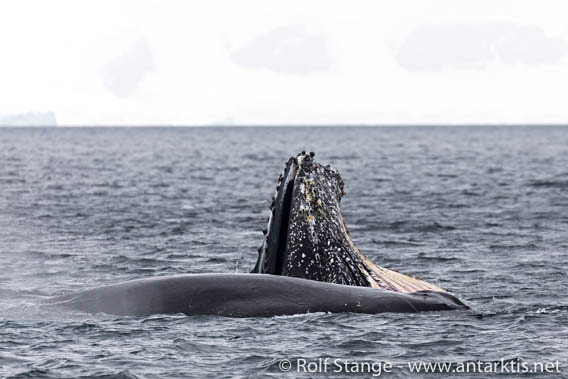
Humpback whales, Antarctica.
At the same time, they used their time in the field to fasten conventional data loggers to the dorsal fin of minke whales. These whales live close to the ice in the southern summer and little is known about them. The scientists hope to gain more information about this sparsely studied whale species. Marine animals that benefit from pack ice habitats are particularly affected by increasing sea temperatures, ocean acidification and increasing strong winds.
Patagonia under sail 2018: triplog and fotos
Following to the triplog and photos of our Antarctic expedition with SY Anne-Margaretha in early 2018, we have now got the Patagonia triplog with associated photo collections and some short storytelling online. With the log, stories and photos, you can join us retrospectively at no cost and enjoy Patagonia’s wonderfully wild landscapes and waterways with no “risk” of wind and waves, seasickness and cold – have fun!

Hiking on one of Patagonia’s many remote islands.
And yes, we are fairly confident that this Patagonia adventure was not the last one of its kind, there is still so much to discover! We have no dates fixed yet, and it won’t happen as early as the next austral season (2018/19), but we’ll return to Patagonia, no doubt!
South Georgia rat eradication project successful
The “South Georgia Habitat Restauration Project” has been followed in several news posts on this website before. This ambitious project is aimed at getting rid of all rats on the island of South Georgia.
Rats are a serious threat for seabirds. Seabird populations on South Georgia have always been impressive, but small in comparison to what they must have been like in times before the whalers incidentally introduced rats to the island. On remote islands which do not have natural predators, seabirds nest on flat ground or in burrows, in any case easily accessible for rats which eat eggs and chicks in massive numbers. After millions of years without rats or other terrestrial predators, seabirds do not have effective mechanisms of defence. Even large species are concerned: there are observations of Wandering albatross chicks being eaten alive on the nest.
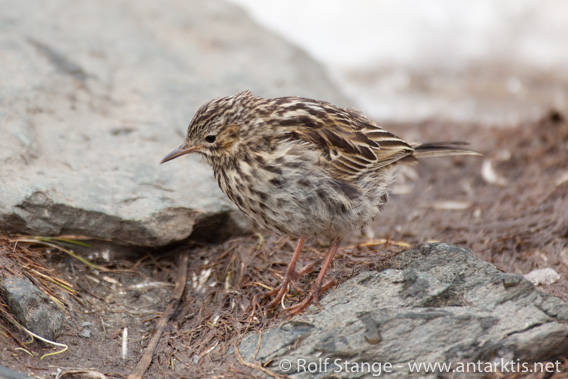
The South Georgia pipit has returned quickly to old breeding areas.
Eradicating rats is always challenging and even more so on such a remote, wild and big island. It had been done successfully especially by New Zealand specialists on islands such as Campbell Island which belongs to New Zealand. The key technique is dropping poisoned bait from helicopters. The bait and dropping technique including timing are designed to eradicate rats while minimising damage to other wildlife. The main phase was completed in South Georgia in early 2015.
As the survival of only one pregnant female rat could ruin the success of the whole project, the subsequent evaluation period is of utmost importance. This phase of intense monitoring has been going on in South Georgia since the completion of the main phase. A comprehensive monitoring expedition has been carried out on South Georgia during the last austral summer season, involving trained dogs and other techniques to make sure no rat could remain undetected. The good news is that “Team Rat” could not find any traces of living rats on South Georgia, as Neil Alison of the South Georgia Heritage Trust (SGHT) could tell the BBC. A SGHT press release declares South Georgia rat-free, for the first time in 200 years!
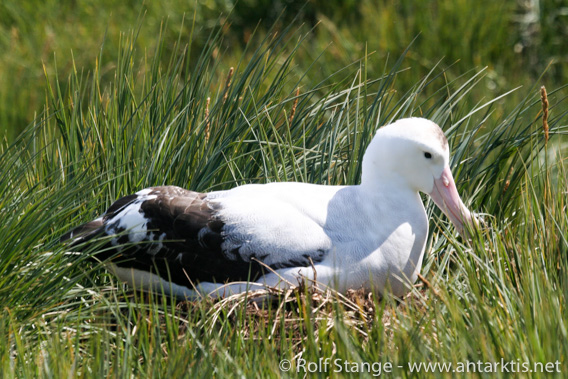
Auch der Wanderalbatros wird von rattenfreien Brutgebieten profitieren.
Birds have started to return to their old breeding grounds quickly after the rats were gone, including the endemic South Georgia pipit. Until 2015, it was restricted to a few places like small, rat-free islands. Since then, it has returned to many areas on the main island of South Georgia. Also larger species including penguins and the majestic Wandering Albatross will benefit from rat-free breeding grounds.
The SGHT had initiated the project and raised about 10 million pounds that were needed mainly through private donations. Tourists contributed about 200,000 pounds per season through auctions and donations on cruise ships to South Georgia.
Postcard set Antarctica: limited edition 2018
Many trips to Antarctica spanning a vast area from South Georgia to the Ross Sea and beyond have yielded a treasure of ten thousands of amazing photos. It was obvious to use them for a stunning set of antarctic postcards. Here it is!
The twelve photos present a wide spectrum of antarctic landscapes and wildlife from South Georgia to Campbell Island and from the Antarctic Peninsula to the Ross Sea. Albatrosses and Penguins (Emperor, Kings, Gentoos and Chinstraps) are in there just as some of Antarctica’s amazing scenery. And as a goody for antarctic gourmets, Scott’s hut at Cape Evans is also represented, with Mount Erebus towering above it.
This set of postcards is available in limited edition. Every set is numbered individually.

The new limited edition postcard set Antarctica with twelve stunning postcards.
Click here for more information about the new postcard set Antarctica.
And by the way – there is of course also a set of Spitsbergen postcards, also new, also limited edition.
Golfo Corcovado to Puerto Montt
Wed
4 Apr
2018
Admittedly, the final leg of our voyage was not what we had been hoping for. We had pictured some beautiful sailing in subtropically calm waters and a nice final stop on the island of Chiloë. Instead, we got one last beating by the weather. Winds around 30 knots (40 in gusts) and straight on the nose, of course. The Golfo de Corcovado did not give us whales and views of volcanoes, but maritime Rock’n’roll in shape of some rough seas, a lot of rain and speed that went down to 1.8 knots at time. Not quite what we wanted. (Addendum: in Puerto Montt, the crew found parts of ropes and fishing nets on the propellor. That explains of course why we made so poor speed when the wind was against us!)
Things improved significantly during the last morning: the wind changed direction and thus its character from a pain in the rear to the sailing wind that we had been hoping for. The sea calmed down, and we picked up speed to make 7-8 knots between Chiloë and some smaller islands towards Puerto Montt. After the wild, lonely landscapes further south, it seemed pretty civilised around here: many smaller and some larger settlements on the islands and more ships than we had seen before in many days. Penguins, pelicans and sea lions were with us on the last miles.
We went alongside in Puerto Montt only a few hours behind schedule, and a really great, beautiful and interesting voyage came to an end, which was duly celebrated with fresh apple cake made by Julie. I am pretty sure that I speak for everybody when I say that we would have loved to continue together. There are so many more Caletas in Patagonia …
But as it was, we said goodbye and farewell. Many big thanks to all fellow travellers, to skipper/boat owner Heinz Wutschke and his good crew, Astrid, Julie and Piet for many stunning days on the back side of Patagonia!
Gallery – Golfo Corcovado to Puerto Montt
- gallery anchor link: #gallery_252
Click on thumbnail to open an enlarged version of the specific photo.
No doubt, this is to be continued. In 2019, we have already got Scoresbysund in east Greenland with Anne-Margaretha on the schedule. There has already been talking about other parts of east Greenland or Lofoten for the future, and I am sure this is not to be the last time in Patagonia! It was far too beautiful for that, and there are so many more places to discover in this stunning part of the globe.
So this is the end of my polar blog for the moment. The author will continue his arctic adventures for a couple of weeks in the book writing factory (yes, there are projects going on). Thanks for reading so far, and see you again when the arctic season starts with Antigua!
Canal Moraledo & Isla Canal
Mon
2 Apr
2018
As if a sunset on a calm fjord between many islands was not already a show of perfect beauty. How does it get even more beautiful? Dolphins.
On Isla Canal, we invented the term „three-dimensional hiking“ because we were moving in the dense forest somehow in a diffuse matrix of branches, bamboo, rotten roots and surprisingly large cavities between them. A very gradual transition from the mostly air-filled space at the top and the more or less solid bottom. Often less solid.
Good fun!
Gallery – Canal Moraledo & Isla Canal – 01/02 April 2018
- gallery anchor link: #gallery_250
Click on thumbnail to open an enlarged version of the specific photo.
According to the weather forecast, we should now have had lovely sailing wind from the south. In reality, we are crossing up north against the wind and some rather rough seas. Still 180 nautical miles to go to Puerto Montt. We will see.
Seno Aysén – 01 April 2018
Sun
1 Apr
2018
Happy Easter! The anchor went down late night. Which was great, we had been sailing for quite some time since we had left our anchorage at the Isla Jungfrauen. And it was good to get to walk again on solid ground! Nature has almost got a tropical aspect, it is so green and lush, big fern trees are growing everywhere like palm trees, and parrots are making a lot of noise.
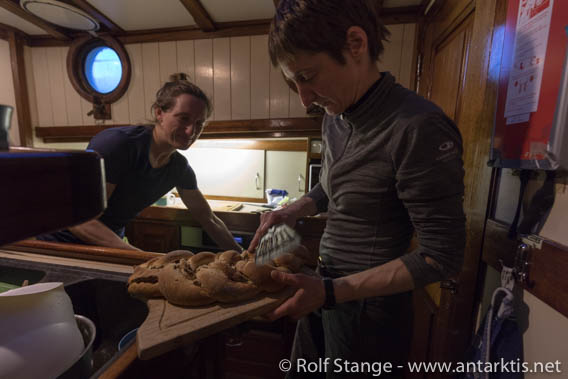
Our own Easter bakery at work
A second landing takes us to some hot springs, the Termas de Punta Perez. It used to be an unknown place in the wilderness until a few years ago, now tourism has left obvious traces. We are obviously getting into more civilized waters again, Puerto Aysén is not too far away and tourist boats and fishing vessels are crowding the waters.
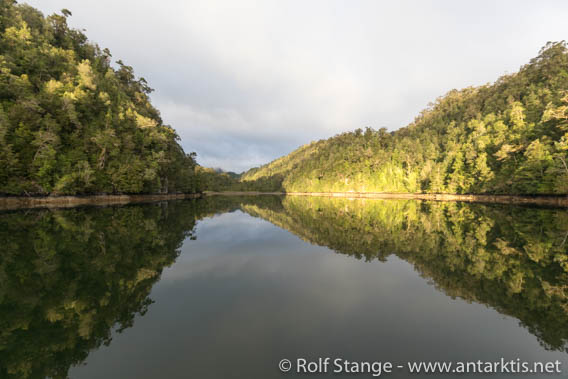
The forest in Seno Aysén looks almost tropical
The hot springs do not form natural hot pools. It is hot groundwater coming out between the stones, so you can burn your bum as you sit in shallow water while your feet get frozen at the same time. It is not really that tropical yet!
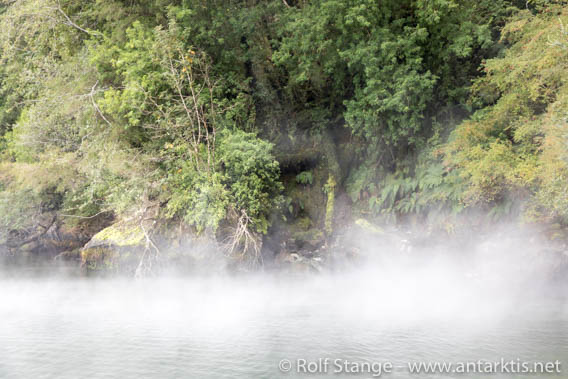
Really hot Hot Springs
Gallery – Seno Aysén – 01 April 2018
- gallery anchor link: #gallery_248
Click on thumbnail to open an enlarged version of the specific photo.
Archipelago de los Chonos – 31 March 2018
Sat
31 Mar
2018
Good to be in sheltered coastal waters again! The surf on the outer coast was very impressive, not a good place to run aground, as countless ships did trough the centuries. We had our bearings right and entered Bahía Anna Pink (one of those lovely placenames again), the entrance to a system of channels through the Archipelago de los Chonos. The sea got completely calm during the morning, the water was like a mirror again mid-day.
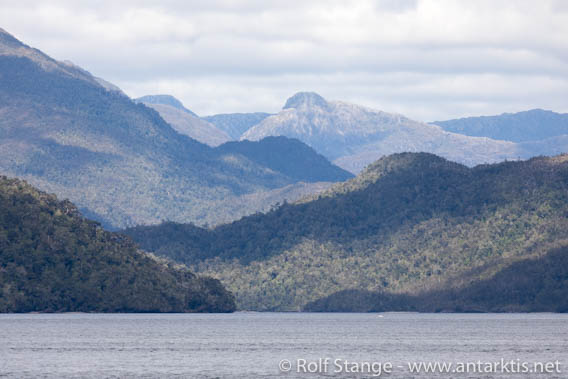
Green trees covering the mountains in the Archipelago de los Chonos
The sun was shining warmly and T-shirts and shorts were seen on the sun deck. Maybe it was just the impression under the coincidence of today’s weather, but everything seems to be milder than south of the Golfo de Penas: the air is warm, the forests are covering the hills up to higher altitudes, the land appears green, lush and mild. Nevertheless, penguins are swimming around in considerable numbers and further inland, there is one of the biggest non-polar ice-caps of the Earth. Maybe it is really just the weather of today …
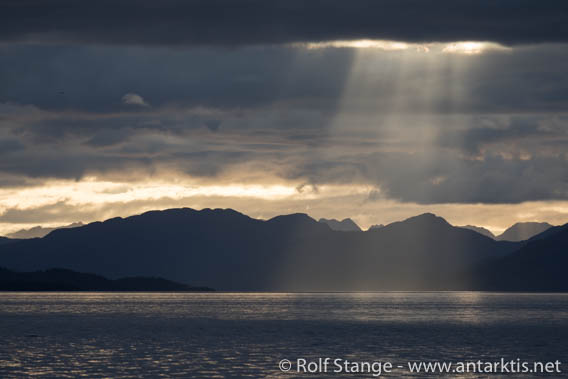
Sunrays hit the water, Canal Chacabuco
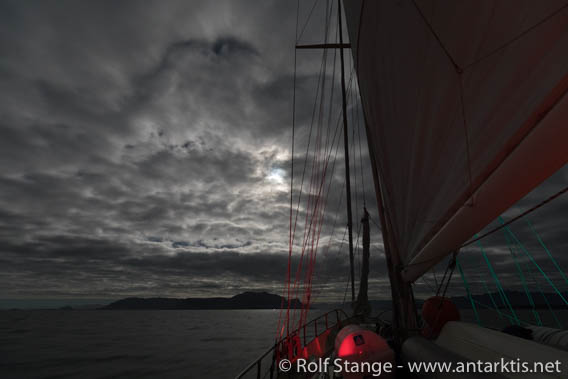
Sailing in the late evening and during the night, across calm waters and in moonlight, is very atmospheric!
Gallery – Archipelago de los Chonos – 31 March 2018
- gallery anchor link: #gallery_246
Click on thumbnail to open an enlarged version of the specific photo.
Peninsula de Taitao – 30 March 2018
Fri
30 Mar
2018
After the sunny hikes on the Isla Jungfrauen, we had to wait out yet another day while the storm was raging out there on open sea.
It was pouring rain for most of the day, so the on-board cinema was by far the best thing to do.
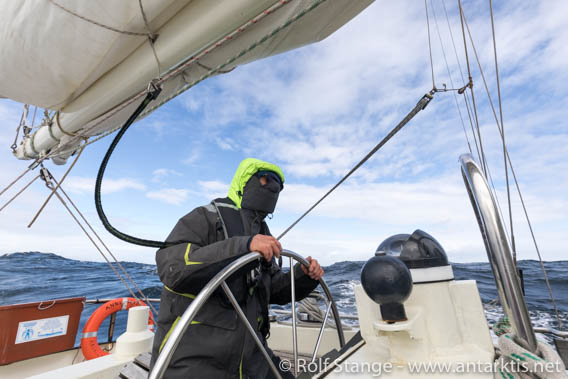
Wind, waves and Albatrosses: sailing at open sea around the Peninsula de Taitao.
Yesterday, we could finally set sail again. We have to get this next leg done, across the Golfo de Penas and around the Peninsula de Ta Ito. We still have 500 nautical miles ahead of us to Puerto Montt, and the days are going quickly.
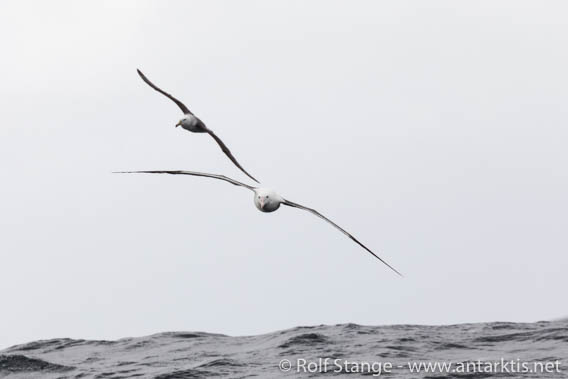
Albatrosses have an enormous wingspan of more than three meters!
The open sea is always something people see with mixed feelings: some have to retreat to their cabins while others are enjoying wind and waves. Representatives of both groups are present on board. But the sailors and photographers amongst us had a lot to enjoy! We made good speed with up to more than 8 knots, wind and waves in constantly changing light conditions and many, many seabirds. From the small petrels to the Grea Albatrosses (Wandering, Northern and Southern Royal Albatross) and a lot in between.
Gallery – Peninsula de Taitao – 30 March 2018
- gallery anchor link: #gallery_244
Click on thumbnail to open an enlarged version of the specific photo.
Isla Jungfrauen – 28/29 March 2018
Wed
28 Mar
2018
We have got the Golfo de Penas ahead of us and thus an open sea passage which will take about one and a half days without the protection of the coastal waters that we have enjoyed so far. It is obviously important to have a good weather window for that, which we were supposed to have now, but reality was different. The wind and sea were quite rough already in the channels, and the latest forecast spoke a quite different but very clear language.
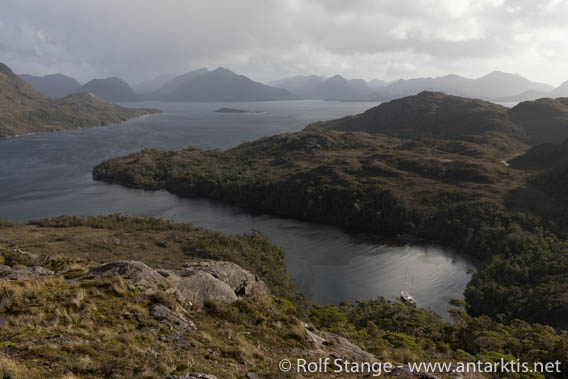
Waiting for the wind to calm down, Isla Jungfrauen
So there is not much to do but to wait for better times regarding the open sea passage. Something that is great at the time being (later, we will have to catch up again, though), as we have got the Isla Jungfrauen nearby, which has the beautiful Caleta Virgin. The name of the island („Island of virgins“) is interesting, but it does not keep the promise, as we have found out by now. But the island has got the beautiful Caleta Virgen, which turned out to be a great place to stay safely with a ship and beyond that, it is a great place for hiking! Once you have got beyond the usual few metres of dense coastal forest, the landscape opens up and offers many great hiking opportunities over hills and smaller mountains with stunning panoramic views, some lakes, wind-beaten trees and a lot of amazing places to discover. An unbelievably beautiful hidden corner of the planet! We were all a bit tired after the last night, but that was quickly forgotten in the beauty of the scenery. And in here, the weather is great! The Caleta is well sheltered, so hardly notice anything of the strong winds and heavy seas outside (on the mountains, you can hardly stand at times) and the sun is with us most of the day. Lovely!
Gallery – Isla Jungfrauen – 28/29 March 2018
- gallery anchor link: #gallery_242
Click on thumbnail to open an enlarged version of the specific photo.
As mentioned, we will have to catch up again time-wise, the days are going and they are not coming back. But we could not have found a better place to wait for better conditions, and when you see the photos, I guess you don’t believe that we are stuck here for weather reasons.
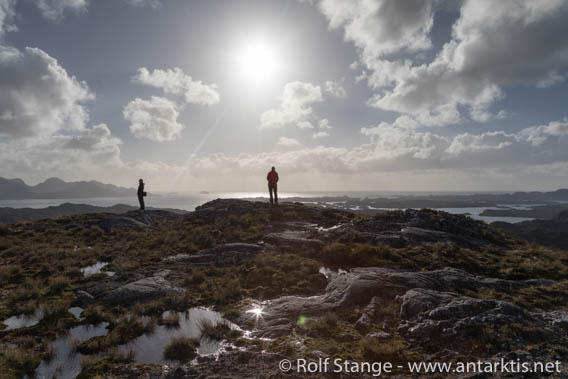
What you can’t see in this picture: Due to strong winds you can hardly stand on some of the higher spots.
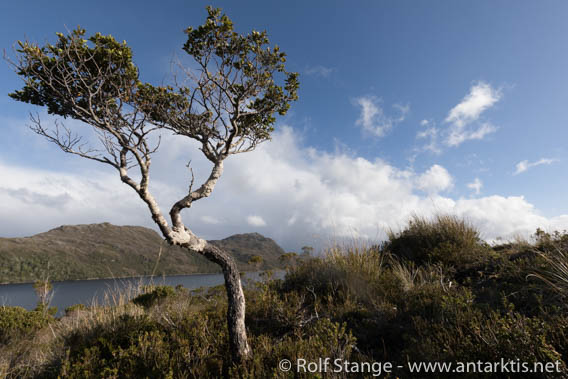
There’s definitely no better place for a day of waiting.
Puerto Edén – 27 March 2018
Tue
27 Mar
2018
Suddenly the weather is on our side again and Caleta Colibri lets us go. The advantage of the quick weather changes is that the weather changes quickly.
After a night and many miles we reach Puerto Edén, which really looks like a bit of a garden Eden on a day like this, under a blue sky and with mirror images on the water. We haven’t had too many days like this!
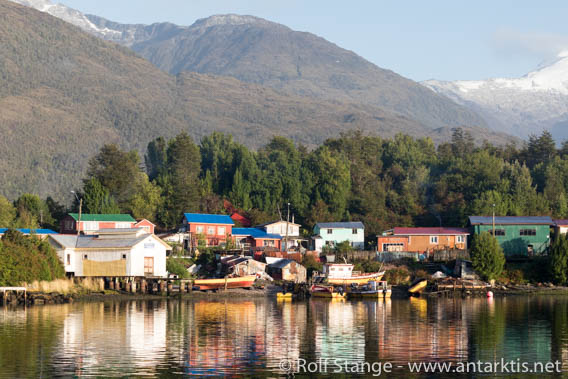
Simple but colourful huts in Puerto Edén
Puerto Edén is a small village with a few hundred inhabitants, most of them descendants of the indigeneous population of this area. The usual, tragic history of colonial murder and diseases has not left many of them alive, and practically nothing of their culture. Instead, there is Puerto Edén, which started its existance as a small airforce base and still has a military presence. Beyond that, it has a number of simple but colourful huts near the shore, which looks beautiful. It is lovely to walk around and enjoy all the views and colours and the weather which feels really mediterranean on a rare day like this. Unfortunatly, my Colobri photo from yesterday (or the day before? Time is flying, it is amazing!) has lost a lot of value as a rarity today, as there are a lot of Colibris around here and the dedicated photographers got rewarded for their patience.
Gallery – Puerto Edén – 27 March 2018
- gallery anchor link: #gallery_240
Click on thumbnail to open an enlarged version of the specific photo.
There are even two shops, but both of them fit into a small room. But there are fishermen who come directly to the boat to offer their fresh catch. Delicious!
In the afternoon and during the night, we make sure that we get further north. We have to, there are still many miles to go and the weather is perfect and of rare beauty.
Caleta Colibri – 25 March 2018
Sun
25 Mar
2018
Caleta Colibri is not a place for long hikes. The forest is so dense that it is simply impossible to get anywhere. I have tried it. It does not work.
But there are several interesting places. In one place, people obviously spent a lot of time eating mussels. There is a big pile of them. Who and when? That’s something we’d also love to know.
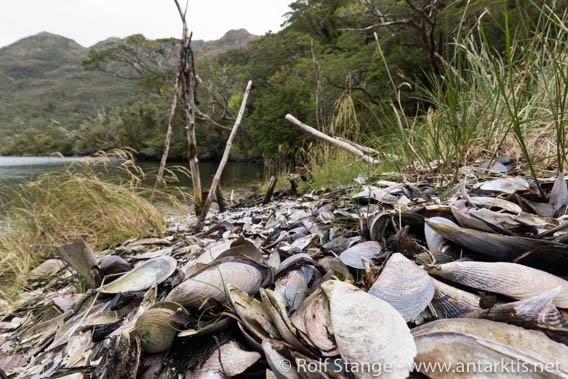
Where do all these mussels come from? Unsolved questions in the Caleta Colibri
You can climb up a tree and it does hardly look different from standing on the ground. Many of them are so densely covered with mosses and all sorts of plants that it looks like the ground. It is all green, everywhere.
And, yes, Caleta Colibri lived up to its name! A small group of dedicated photographers waited patiently to get a chance, and we were rewarded. I would guess it was a Green-backed firecrown (Sephanoides sephanoides), according to our book „Bird of Chile“.
Gallery – Caleta Colibri – 25 March 2018
- gallery anchor link: #gallery_238
Click on thumbnail to open an enlarged version of the specific photo.
Now the wind has to calm down a bit so we can continue towards Puerto Edén. That is the next place we are heading for and the first place since Puerto Williams where people are living. We have to go shopping, we are running out of chocolate and beer.

Nomen est omen: Caleta Colibri
Canal Tres Corres – 25 March 2018
Sun
25 Mar
2018
After a real Sunday morning breakfast (scrambled eggs and fresh rolls!) it was time to move northwards again. Wind and rain in Canal Pitt, stunning light later, sun and blue sky alternating with some light clouds.
The wind is supposed to pick up again strongly tonight, so we decide to hide in Caleta Colibri. A lovely place for a calm night. And maybe the name keeps the promise ..?

A lovely bay with a promising name: Caleta Colibri, Canal Tres Corres
Gallery – Canal Tres Corres – 25 March 2018
- gallery anchor link: #gallery_235
Click on thumbnail to open an enlarged version of the specific photo.
Caleta Villarica – 24 March 2018
Sat
24 Mar
2018
After a long day out and a forecast with a lot of wind for the night, what we needed was a good Caleta to provide a sheltered anchorage for a night.
Caleta Villarica can be recommended for that purpose. It starts a bit like Deception Island: you approach a steep coast, a narrow entrance with rocks in the water, steep cliffs on both sides (a bit greener here than on Deception Island), everybody starts placing bets if the ship will actually fit through it – of course, it works, the skipper knows what he is doing. Then, a lovely bay opens, a real pirate hideaway. A lovely place to make a ship stormproof for the night.
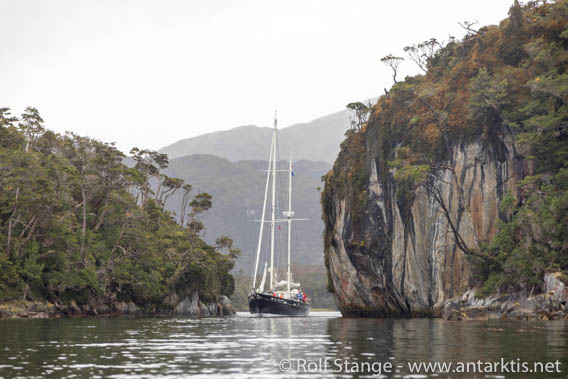
Will it fit? It will! Caleta Villarica
Walking in these forests is not for the faint-hearted. We could have used a chainsaw, ropes and a ladder for that little walk which in open terrain would have taken maybe 10 minutes. Indiana Jones would have been amazed by the density of this rain forest.
As always, the view was worth it!
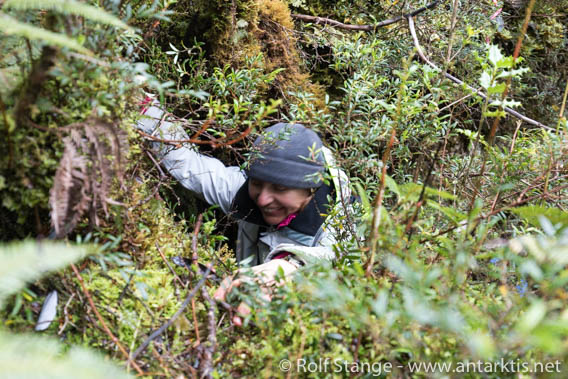
Indiana Jones would have enjoyed this: Dense forest in the Caleta Villarica
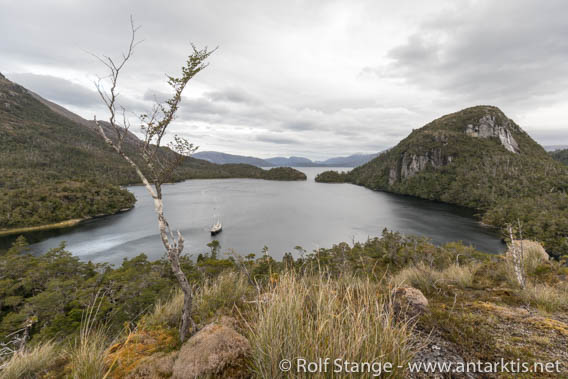
The amazing view over Caleta Villarica was worth the struggle through the bush
Gallery – Caleta Villarica – 24 March 2018
- gallery anchor link: #gallery_233
Click on thumbnail to open an enlarged version of the specific photo.
News-Listing live generated at 2025/May/09 at 05:39:49 Uhr (GMT+1)






















































































































































